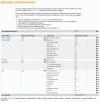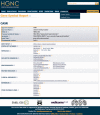Genenames.org: the HGNC resources in 2013
- PMID: 23161694
- PMCID: PMC3531211
- DOI: 10.1093/nar/gks1066
Genenames.org: the HGNC resources in 2013
Abstract
The HUGO Gene Nomenclature Committee situated at the European Bioinformatics Institute assigns unique symbols and names to human genes. Since 2011, the data within our database has expanded largely owing to an increase in naming pseudogenes and non-coding RNA genes, and we now have >33,500 approved symbols. Our gene families and groups have also increased to nearly 500, with ∼45% of our gene entries associated to at least one family or group. We have also redesigned the HUGO Gene Nomenclature Committee website http://www.genenames.org creating a constant look and feel across the site and improving usability and readability for our users. The site provides a public access portal to our database with no restrictions imposed on access or the use of the data. Within this article, we review our online resources and data with particular emphasis on the updates to our website.
Figures




Similar articles
-
Genenames.org: the HGNC resources in 2015.Nucleic Acids Res. 2015 Jan;43(Database issue):D1079-85. doi: 10.1093/nar/gku1071. Epub 2014 Oct 31. Nucleic Acids Res. 2015. PMID: 25361968 Free PMC article.
-
Genenames.org: the HGNC resources in 2023.Nucleic Acids Res. 2023 Jan 6;51(D1):D1003-D1009. doi: 10.1093/nar/gkac888. Nucleic Acids Res. 2023. PMID: 36243972 Free PMC article.
-
Genenames.org: the HGNC and VGNC resources in 2017.Nucleic Acids Res. 2017 Jan 4;45(D1):D619-D625. doi: 10.1093/nar/gkw1033. Epub 2016 Oct 30. Nucleic Acids Res. 2017. PMID: 27799471 Free PMC article.
-
Gene family matters: expanding the HGNC resource.Hum Genomics. 2012 Jul 5;6(1):4. doi: 10.1186/1479-7364-6-4. Hum Genomics. 2012. PMID: 23245209 Free PMC article. Review.
-
A review of the new HGNC gene family resource.Hum Genomics. 2016 Feb 3;10:6. doi: 10.1186/s40246-016-0062-6. Hum Genomics. 2016. PMID: 26842383 Free PMC article. Review.
Cited by
-
DigSee: Disease gene search engine with evidence sentences (version cancer).Nucleic Acids Res. 2013 Jul;41(Web Server issue):W510-7. doi: 10.1093/nar/gkt531. Epub 2013 Jun 12. Nucleic Acids Res. 2013. PMID: 23761452 Free PMC article.
-
Finding directionality and gene-disease predictions in disease associations.BMC Syst Biol. 2015 Jul 15;9:35. doi: 10.1186/s12918-015-0184-9. BMC Syst Biol. 2015. PMID: 26168918 Free PMC article.
-
Gene Expression Profile Analyses of the Skin Response of Balb/c-Nu Mice Model Injected by Staphylococcus aureus.Clin Cosmet Investig Dermatol. 2022 Feb 15;15:217-235. doi: 10.2147/CCID.S348961. eCollection 2022. Clin Cosmet Investig Dermatol. 2022. PMID: 35210800 Free PMC article.
-
Identification of pharmacodynamic biomarker hypotheses through literature analysis with IBM Watson.PLoS One. 2019 Apr 8;14(4):e0214619. doi: 10.1371/journal.pone.0214619. eCollection 2019. PLoS One. 2019. PMID: 30958864 Free PMC article.
-
Integrative transcriptome meta-analysis reveals widespread sex-biased gene expression at the human fetal-maternal interface.Mol Hum Reprod. 2014 Aug;20(8):810-9. doi: 10.1093/molehr/gau035. Epub 2014 May 27. Mol Hum Reprod. 2014. PMID: 24867328 Free PMC article.
References
Publication types
MeSH terms
Substances
Grants and funding
LinkOut - more resources
Full Text Sources
Other Literature Sources
Medical

